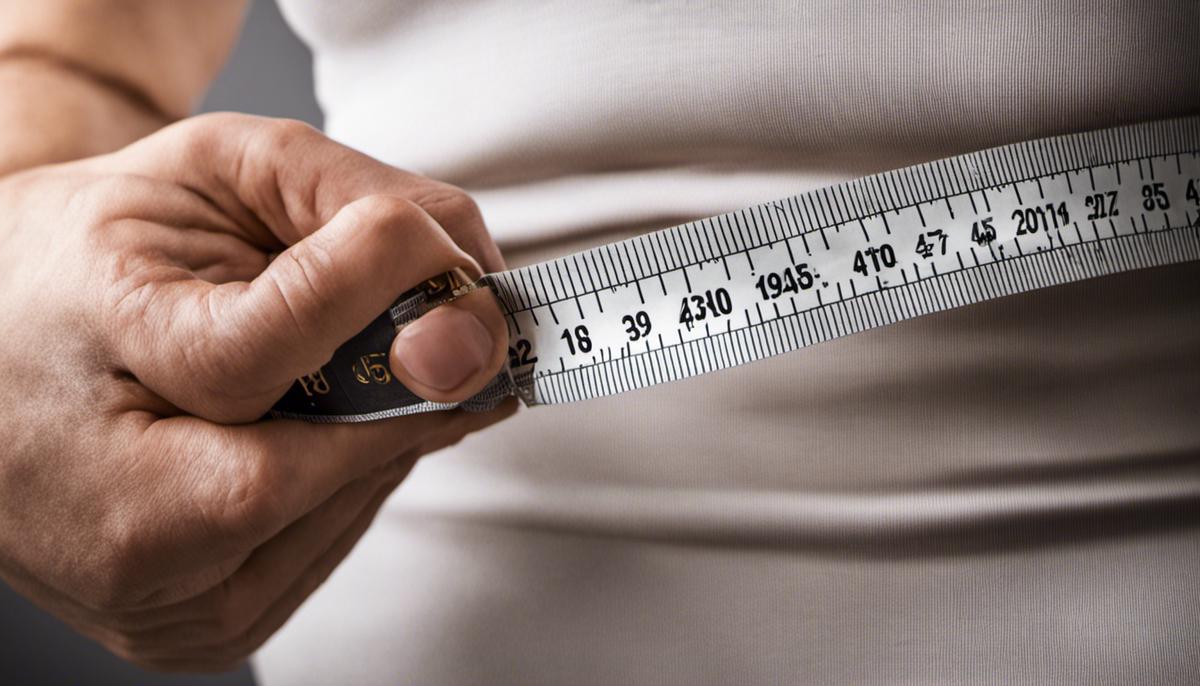In our journey towards optimal health and fitness, various factors play essential roles in determining our progress and status. Two fundamental components, often overlooked, are the concepts of girth measurement and weight. Understanding these metrics not only helps us to track and assess individual progress effectively, but also provides a practical tool for professionals in the field. This article embarks on an engaging exploration into these pivotal aspects, discussing their meaning, correlations and implications for our health and overall fitness. Furthermore, it offers a practical guide on techniques and tools that can be used to measure girth and weight, helping the readers to stay informed and make data-informed decisions on their fitness journey.
Understanding Girth Measurement and Weight
Definition and Importance of Girth Measurement
Girth measurement is a method used to determine the size and proportion of different body parts. This can include various regions of the body such as arms, thighs, waist, and hips. Typically, these measurements are taken using a tape measure and are often used in fitness and health contexts. For instance, personal trainers may use girth measurements to track a client’s progress, while health professionals might use them to assess risk factors for certain diseases.
The importance of girth measurement lies in its potential to provide deep insights into a person’s health and fitness levels. Unlike body weight, which gives a whole-body measurement, girth measurements provide a more targeted outlook on specific body regions. This allows for a more in-depth understanding of an individual’s body composition, as it can highlight areas of muscle growth or fat accumulation.
Understanding Weight and Its Role in Health
Weight, on the other hand, is a measure of the overall mass of an individual. This is generally measured using scales and, like girth measurements, serves as a key indicator of a person’s health. Weight can provide an overview of an individual’s fitness level, where abnormal weight levels – either too high or too low – can indicate potential health issues.
Ideal weight levels can vary significantly between individuals, being influenced by factors such as age, sex, and height. It’s also important to remember that weight can be influenced by both fat and muscle mass – hence the reason why athletes might weigh more but still be in excellent health.
Girth Measurement and Weight: Their Interrelation
The interconnection of girth measurement and weight is intricate and significant. For example, an elevation in girth measurements, particularly in areas susceptible to fat accumulation such as the waist and hips, may lead to an increase in body weight. However, it’s crucial to remember that weight alone doesn’t completely depict a person’s health status.
For instance, athletes with more muscle mass may be heavier. Conversely, individuals with a smaller girth but a high body fat percentage may weigh less. However, this doesn’t automatically classify them as healthier. Therefore, girth measurement and body weight, when jointly evaluated, provide a more accurate representation of a person’s fitness and wellbeing as they both carry equal importance.

Correlation between Girth Measurement and Weight
The Significance of Girth Measurement in Conjunction with Weight
Girth measurement is a common method employed to estimate body fat and overall body composition. It involves the utilization of a tape measure to measure the circumference of various body parts, including the waist, hips, chest, arms, and thighs. Along with data like weight and height, these measurements provide a comprehensive insight into a person’s health condition. Therefore, girth measurements have a significant role when an assessment of health based on weight is conducted.
The Role of Girth Measurement and Weight in Health Assessments
Although weight is a common indicator for health, relying solely on it can be misleading. This is primarily because weight does not distinguish between the mass of muscle and the mass of fat. Thus, a person may have a relatively normal weight but still have too much accumulated fat, a condition known as “normal weight obesity.” Therefore, girth measurements become essential in portraying a more comprehensive picture of a person’s health status in conjunction with weight.
Correlation between Girth Measurement and Weight
According to numerous scientific studies, there is a strong correlation between girth measurements, notably waist circumference and weight. An increase in weight is related to an increase in girth measurements, specifically in areas where the body tends to store excess fat, like the waist and hips. Similarly, a decrease in weight often correlates with a reduction in these measurements.
Girth Measurement as an Indicator of Weight Change
Girth measurements can indeed serve as an indicator of weight change. An increase in waist or hip circumference can signal weight gain, while a decrease can suggest weight loss. The key here is consistent measurement practices and keeping track of changes over time. However, one must bear in mind that changes in girth measurements could be a result of changes in muscle mass or fluid balance and is not exclusively confined to changes in fat mass.
Research and Trends
Studies on body girth measurement and weight indicate that measuring the waistline is an effective way of predicting obesity and related health issues like diabetes and cardiovascular diseases. Recent years have seen an increasing emphasis on waist circumference as an essential health indicator. For instance, increased waist circumference and elevated body mass index (BMI) have been associated with a higher risk of health problems.
As trends go, there is a documented shift from focusing solely on weight to considering girth measurements. This approach provides a more comprehensive understanding of an individual’s health, especially related to obesity and potential health risks.
Important Considerations Regarding Girth Measurement
Gauging the circumference of various areas of the body, known as girth measurements, can offer a myriad of key health insights. However, it’s crucial to understand their inherent limitations. Factors such as fluctuations in muscle mass, alterations in fluid balance and changes in fat distribution can all significantly impact one’s girth measurements. As such, these measurements are most beneficial when used within the context of a broader, more in-depth health evaluation.

Implications of Girth Measurement on Health and Fitness
Benefits of Girth Measurement in Fitness and Health
Essentially, girth measurements provide a straightforward and effective method of tracking alterations in your body composition over time. These measurements are fundamentally important because weight alone isn’t an exhaustive representation of your health or fitness level.
Within the health and fitness industry, practitioners frequently employ girth measurement to establish a baseline that helps evaluate a person’s progress during fitness or weight reduction programs. They are especially useful in assessing body composition because the size of various body parts, including waist, hip, and arm, can reveal significant details about an individual’s diet, workout regimen, and overall health.
The Relationship between Body Girth and Weight
The correlation between body girth and weight is significant. While weight can indicate overall body mass, girth measurements can offer a more detailed perspective on body composition, including muscle gain and fat loss. For instance, losing inches from your waist even without significant weight loss can be indicative of fat loss and muscle gain, a fact often overlooked when seeking weight loss as the primary goal.
Conversely, if there’s an increase in girth measurements without a significant weight change, it could indicate an increase in lean muscle mass, especially if the individual is regularly exercising and consuming a protein-rich diet. Therefore, girth measurements are necessary to provide a broader and more accurate image of body composition changes beyond just weight loss or gain.
Implications of Girth Measurement on Health
Girth measurements, especially around the waist, can indicate potential health risks. For instance, increased waist girth is associated with a higher risk of obesity-related diseases such as heart disease, type 2 diabetes, and high blood pressure. The National Heart, Lung, and Blood Institute suggests that a waist circumference greater than 35 inches for women and 40 inches for men is a high-risk factor for these diseases.
Furthermore, girth measurement ratios like the waist-to-hip ratio can aid in predicting health risks. A high waist-to-hip ratio suggests that there’s excess abdominal fat, colloquially known as “belly fat,” which is linked with higher cholesterol levels, inflammation, insulin resistance, and heart disease.
Applying Girth Measurement in Fitness and Health
Within the fitness realm and the sport of bodybuilding, girth measurements have become a primary method to monitor the development of muscles and the reduction of fat in various areas of the body such as the arms, chest, waist, hips, and thighs. By observing fluctuations in girth measurements, it becomes possible to customize your diet and exercise routine to fit specific objectives. For example, an increase in the girth of the arms or chest may suggest that a training regimen aimed at muscle hypertrophy is proving fruitful.
In essence, the utilization of girth measurements functions as a valuable asset within the health and fitness industry. It allows for health status and fitness advancement to be monitored, diagnosed, and predicted, providing not only insight into weight but also a comprehensive understanding of overall body composition and health condition. The multifaceted nature of girth measurement offers a more in-depth perspective compared to weighing alone, making it beneficial for both individuals monitoring their personal health and fitness achievements, as well as professionals offering guidance to them.

Techniques and Tools for Measuring Girth and Weight
Comprehending Girth and Weight Measurements
The measurements of girth and weight serve as vital tools for assessment in the fields of health and fitness. Girth measurement is the process of measuring the circumference of a particular body part, whereas weight measures the entire mass of one’s body. When considered together, these indicators provide a comprehensive picture of a person’s physical health status. This could encompass general health as well as the likelihood of developing disorders associated with obesity.
Concept of Girth Vs Weight
Girth and weight, although both measured and monitored for health reasons, are different and represent different aspects of the body. Girth is specific to the circumference of a particular body part, such as the waist or hip, and it can give a direct indication of fat distribution and accumulation in the body. Weight, on the other hand, is a more overall measure of an individual’s mass including bones, organs, muscle, and fat. Within this context, a person may have increased body weight due to larger muscle mass rather than fat accumulation. Therefore, considering both girth and weight measurements is necessary for a comprehensive health assessment.
Measurement Techniques: Girth and Weight
There are standardized methods for taking girth and weight measurements. For girth, a flexible and non-stretchable measuring tape is typically used. Measurements are generally taken at several body sites, including the chest, waist, hips, thighs, and upper arms, depending on the goal of the assessment. For accurate results, the tape should be snug but not depressing the skin.
Weighing oneself, on the other hand, typically involves the use of a scale. The most accurate scales are those that are digital and can be adjusted to zero before stepping onto them. It’s best to weigh oneself on a solid surface rather than on a carpet, and at a similar time each day due to natural weight fluctuations throughout the day.
Tools for Measuring Girth and Weight
There are multiple tools available for taking girth and weight measurements, ranging from the simple to the sophisticated. It must be remembered that the accuracy of the measurements largely depends on the quality of the tools and the consistency in the method of measurement.
Common girth measurement tools include simple measuring tapes that are made of cloth or plastic. These tools are typically inexpensive and easy to use. More advanced tools may include spring-loaded tape measures or body calipers which can provide more precise readings.
Weight scales are available in a variety of types, including mechanical, digital, and smart scales. Mechanical scales can be less accurate than digital ones, due to inconsistencies in the gravity measurement across different locations and gradual loss of calibration over time, while smart scales, connected to mobile apps, can track weight changes over time and even provide additional data like body fat percentage.
Ensuring the tools are used correctly and maintained well are key to obtaining accurate readings.
Interpreting Girth and Weight Measurements
Interpreting girth and weight measurements is an important aspect of health assessment. While a higher body weight may not necessarily signify poor health, disproportionate girth measurements or a high waist-to-hip ratio can suggest unhealthy fat distribution, a risk factor for metabolic conditions.
Conversely, having a healthy weight but a large waist girth may still create health risks. Therefore, both girth and weight measurements should be taken into account for a comprehensive health assessment, and changes in each may need to be monitored differently.
It is also crucial to consider these values in the context of other health indicators such as age, exercise habits, and dietary patterns. Remember, too, that self-assessment should not replace regular health checks by a professional, who can interpret these measures more accurately within the larger context of individual health.

Grasping the significance of girth measurements and weight can profoundly influence our perception of health and fitness. These metrics are not only critical indicators of our physical condition, but they also allow us to construct more effective, personalized health and fitness regimes. We’ve delved into the deep correlations between these two metrics and clarified their implications on overall health. Alongside, we provided insights into precise techniques and tools to measure them. By understanding and applying this essential knowledge, anyone can take substantial strides toward better health, increased fitness, and ultimately, a life of increased vitality and happiness.
